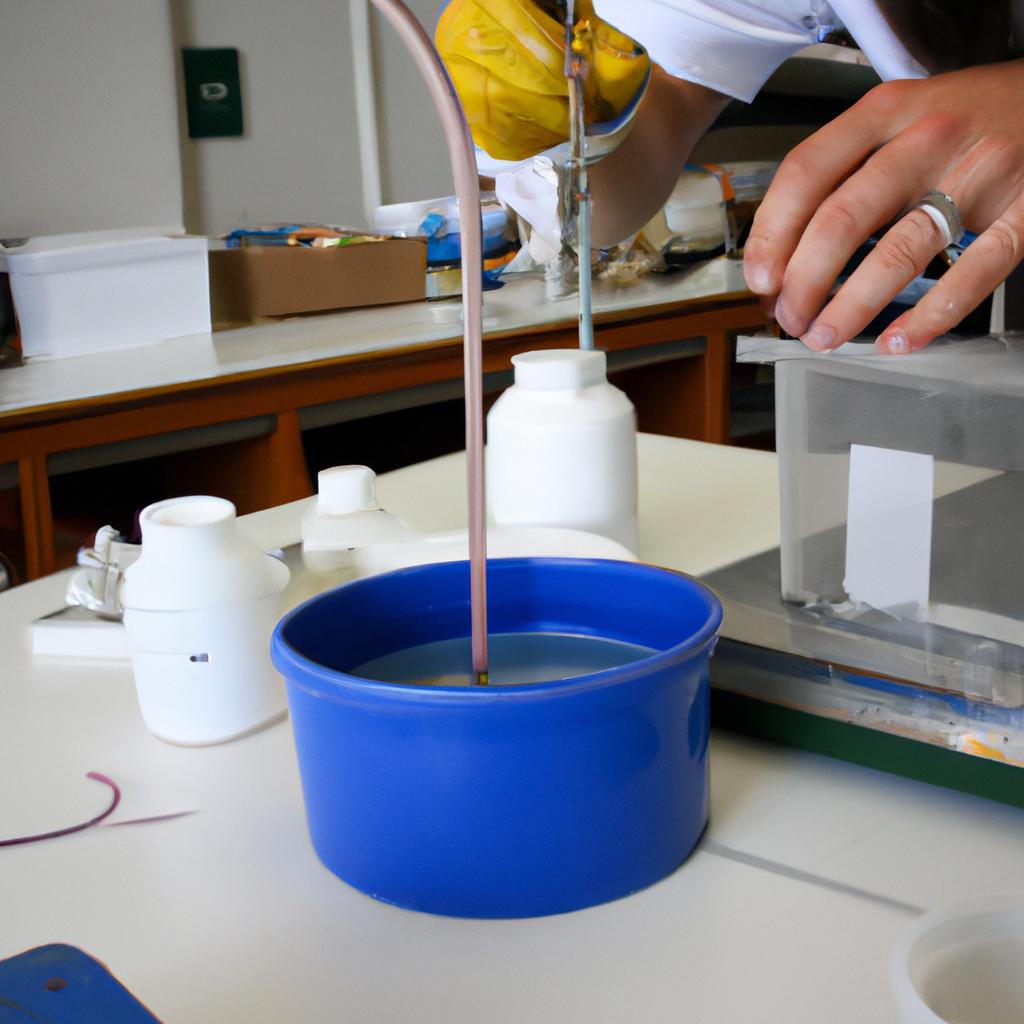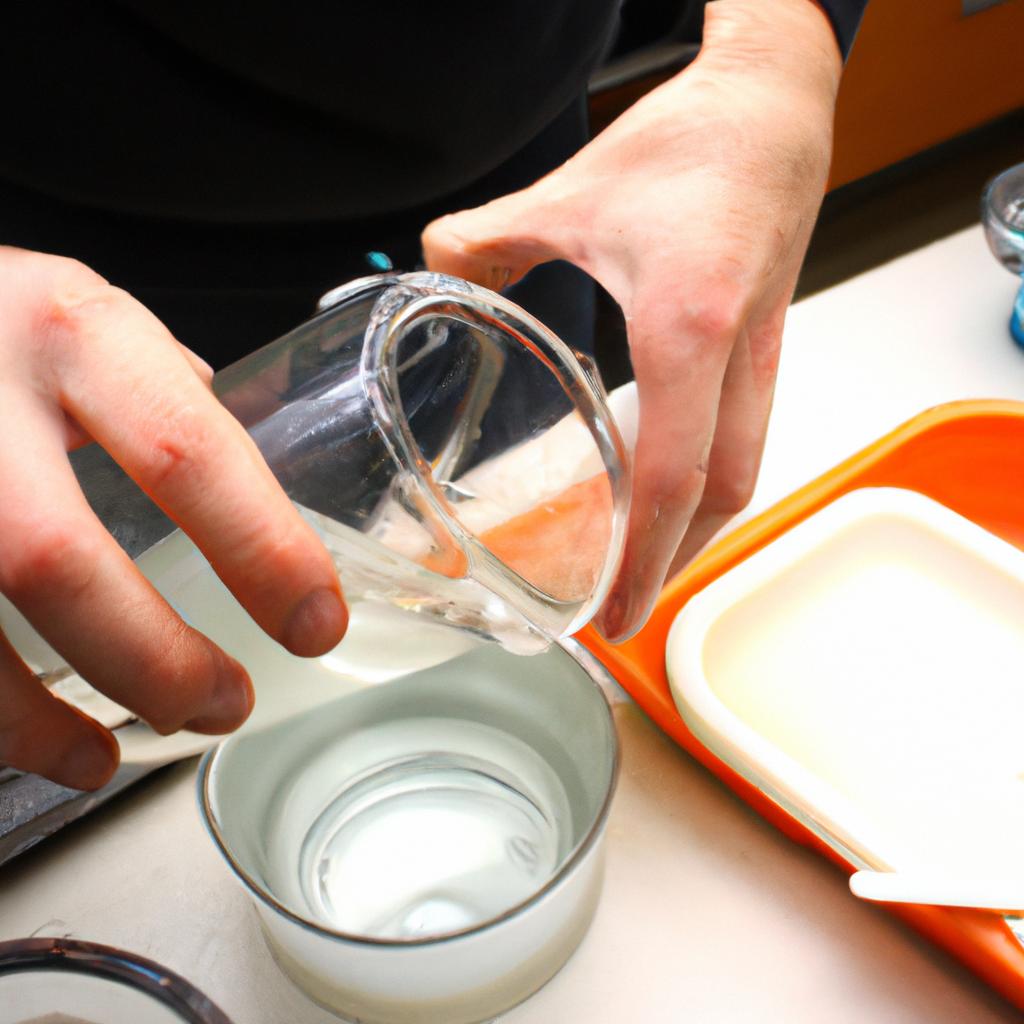Stokes Law in Floating: Fluid Mechanics Explained

In the study of fluid mechanics, one concept that is often encountered is Stokes Law. This law provides a mathematical relationship between the velocity of a small spherical particle moving through a viscous fluid and the drag force experienced by the particle. Understanding Stokes Law in floating is crucial for analyzing various phenomena such as sedimentation, filtration, and even the behavior of microscopic organisms in water.
To illustrate this concept, let us consider the case of a tiny pollen grain floating on the surface of calm water. As we observe this seemingly simple scenario, it becomes apparent that there are intricate forces at play governing its motion. By delving into the principles behind Stokes Law, we can unravel these complexities and gain insights into how particles interact with fluids in buoyant conditions. Through an exploration of the underlying mathematics and physical concepts involved, this article aims to shed light on Stokes Law in floating and provide a comprehensive understanding of its significance within fluid mechanics research.
What is Stokes Law?
Stokes Law, named after the British mathematician and physicist Sir George Gabriel Stokes, describes the motion of small particles suspended in a fluid. It provides a mathematical model that predicts the drag force experienced by these particles as they move through the fluid.
To better understand this concept, let us consider an example scenario. Imagine a tiny particle floating in a still liquid. As the particle descends due to gravity, it experiences resistance from the surrounding fluid. This resistance is called drag force and acts opposite to the direction of motion. According to Stokes Law, this drag force can be calculated based on various factors such as fluid viscosity, size and shape of the particle, and relative velocity between the particle and the fluid.
To illustrate how important Stokes Law is in understanding fluid mechanics, consider these points:
-
Bullet Point List:
- The study of Stokes Law has applications in diverse fields like engineering, biology, geology, and environmental sciences.
- Understanding drag forces helps design more efficient transportation systems such as airplanes or submarines.
- Medical researchers use Stokes Law principles to investigate blood flow dynamics within our bodies.
- Environmental scientists analyze sedimentation rates using Stokes Law when studying water pollution levels.
Additionally, we can visualize some key parameters involved in Stokes’ law with a table:
| Parameters | Description |
|---|---|
| Fluid Viscosity | Determines how resistant the fluid is |
| Particle Size | Influences surface area for interaction |
| Particle Shape | Affects flow disturbance around it |
| Relative Velocity | Speed at which particle moves |
In conclusion,
Stokes Law plays a crucial role in understanding the behavior of particles immersed within fluids. By considering factors such as viscosity, size, shape, and velocity, we can accurately predict drag forces acting on these particles. Now let’s delve deeper into another fundamental principle related to fluid mechanics – the Principle of Viscosity.
The Principle of Viscosity
To further grasp this concept, let us explore the principle of viscosity and its significance in relation to Stokes Law.
Consider a scenario where a small spherical particle is dropped into a liquid medium. This particle experiences resistance due to the viscosity of the fluid surrounding it. Viscosity refers to the internal friction within a fluid that resists its flow or deformation. In simpler terms, it can be thought of as the “stickiness” or thickness of a fluid.
To better understand how viscosity affects the motion of an object through a fluid, we can examine some key factors:
-
Particle Size: The larger the size of the particle relative to the molecules in the fluid, the more pronounced the effect of viscosity becomes. Smaller particles experience less resistance compared to larger ones.
-
Fluid Properties: Different fluids have varying viscosities. For example, honey has higher viscosity than water, resulting in greater resistance for objects moving through honey compared to water.
-
Shape and Density: The shape and density of an object also influence its interaction with viscous forces. Irregularly shaped objects experience more drag than smooth spheres due to increased surface area interacting with the fluid.
-
Speed: The speed at which an object moves through a fluid impacts how much drag force it experiences. Higher velocities lead to stronger viscous forces acting on the object.
The table below highlights these factors:
| Factors Affecting Viscosity | Impact |
|---|---|
| Particle Size | Larger particles experience more resistance due to their increased contact area with the fluid. |
| Fluid Properties | Liquids with higher viscosities result in stronger drag forces acting on submerged objects. |
| Shape and Density | Objects with irregular shapes or high densities encounter greater resistance from viscous forces compared to smooth spheres or lower density objects. |
| Speed | Higher velocities lead to stronger viscous drag forces acting on the object, impeding its motion through the fluid. |
Understanding these factors allows us to comprehend how Stokes Law operates in practical applications and real-world scenarios. In the subsequent section, we will delve into the relationship between drag force and terminal velocity, further expanding our comprehension of fluid mechanics.
Transitioning seamlessly from this discussion, let us explore the fascinating connection between drag force and an object’s terminal velocity.
The Relationship between Drag Force and Terminal Velocity
Having established a solid understanding of the principle of viscosity, we now turn our attention to exploring the relationship between drag force and terminal velocity. To illustrate this concept, let us consider an example scenario where a small plastic sphere is dropped into a pool of water. As it descends through the fluid, various forces come into play that determine its motion.
Section – The Relationship between Drag Force and Terminal Velocity:
When the plastic sphere initially enters the water, gravity pulls it downward with a constant force. However, as it gains speed, another opposing force arises – drag force. This force is exerted by the surrounding fluid on any object moving through it. In particular, according to Stokes Law in floating, drag force can be calculated using the equation F = 6πηrv, where η represents dynamic viscosity, r denotes radius, and v signifies velocity.
To grasp how these factors interact within a fluid medium like water, consider the following observations:
- Dynamic viscosity (η): The higher the dynamic viscosity of the liquid medium, such as honey or syrup compared to water, the stronger the resistance encountered by an object moving through it.
- Radius (r): A larger radius results in increased surface area exposed to drag force, leading to greater opposition against motion.
- Velocity (v): As an object speeds up while descending through fluid due to gravity’s pull, drag force also increases proportionally until they reach equilibrium at terminal velocity.
Let’s explore these relationships further through a table highlighting different scenarios involving varying parameters:
| Scenario | Dynamic Viscosity | Sphere Radius | Initial Velocity |
|---|---|---|---|
| Scenario 1 | Low | Small | High |
| Scenario 2 | Medium | Medium | Moderate |
| Scenario 3 | High | Large | Low |
As we can see from the table, each scenario presents unique combinations of fluid properties and object characteristics. These variations directly influence the drag force experienced by the sphere and subsequently affect its terminal velocity.
Understanding the relationship between drag force and terminal velocity is crucial in comprehending how objects float or sink within a fluid medium. In our subsequent section on “Factors Affecting Floating and Terminal Velocity,” we will delve deeper into additional aspects that contribute to this phenomenon, expanding upon these fundamental principles without skipping a beat.
Factors Affecting Floating and Terminal Velocity
To further understand this concept, let’s consider an example: imagine a small wooden block being dropped into a pool of water. As the block descends through the liquid, it encounters resistance from the surrounding fluid molecules. This resistance is what we refer to as drag force.
To delve deeper into how drag force affects floating objects, there are several factors that come into play:
-
Size and shape: The size and shape of an object greatly influence its interaction with fluids. Objects with larger surface areas experience greater drag forces due to increased contact with the fluid molecules.
-
Density difference: The density of both the object and the fluid it’s submerged in also plays a significant role in determining drag force. If the object has higher density than the fluid, it tends to sink faster due to stronger gravitational pull; however, if its density is lower than that of the fluid, buoyancy comes into effect.
-
Viscosity of the fluid: Fluid viscosity refers to its resistance to flow. Liquids with high viscosity (e.g., honey) have more frictional forces acting on objects moving through them compared to low-viscosity liquids (e.g., water).
-
Fluid speed: The velocity at which a fluid moves can affect drag force as well. Higher speeds increase turbulence in the flow, leading to increased drag forces experienced by floating objects.
Now that we have examined these key factors affecting floating objects’ behavior in relation to drag forces, let us move on to explore various applications of Stokes Law in understanding such phenomena.
Applications of Stokes Law in Floating Objects
In the previous section, we discussed the factors that affect floating and terminal velocity. Now, let’s delve into the applications of Stokes Law in understanding the behavior of floating objects.
To illustrate this concept, consider a hypothetical scenario where a small wooden block is placed on the surface of water. As soon as it is released, the block starts to sink but eventually reaches a point where it stops sinking and begins to float. This transition from sinking to floating can be explained by Stokes Law.
Stokes Law states that for small particles or objects moving through a viscous fluid, such as water, there exists an equilibrium between gravitational force acting downwards on the object and the buoyant force exerted upwards by the fluid. When these two forces balance out, the object attains its terminal velocity and floats at a certain height within the fluid.
The applications of Stokes Law in understanding floating objects are vast. Here are some key points to consider:
- Determining density: By measuring the terminal velocity of an object in a known liquid medium using Stokes Law, scientists can determine its density. This information proves valuable in various fields such as material science and environmental studies.
- Analyzing particle size: The application of Stokes Law extends beyond solid objects; it is also used to analyze suspended particles in fluids. Particle size distribution can be determined by observing their sedimentation rates under gravity.
- Design considerations: Engineers often utilize Stokes Law when designing structures that interact with fluids. For example, calculating drag forces experienced by ships or submarines allows for optimizing their shapes and reducing energy consumption.
- Environmental impact assessment: Understanding how pollutants disperse in natural bodies of water is crucial for assessing their potential harm to ecosystems. By applying Stokes Law, researchers can study how specific substances move within different liquids and predict their effects over time.
These applications highlight how Stokes Law plays a vital role in advancing our knowledge of fluid mechanics and its practical implications.
[Table]
| Application | Importance |
|---|---|
| Determining density | Provides insights into material properties |
| Analyzing particle size | Allows for characterization of suspended particles |
| Design considerations | Enhances engineering efficiency |
| Environmental impact assessment | Aids in understanding pollutant dispersion |
[End of Section]
Limitations and Assumptions of Stokes Law
As we delve deeper into the applications of Stokes Law, it becomes evident that this principle finds extensive use in understanding and analyzing floating objects. By considering the forces acting on an object in a fluid medium, Stokes Law provides valuable insights into various scenarios involving buoyancy and equilibrium.
One example where the application of Stokes Law is particularly relevant is when studying the behavior of submarines. Submarines are designed to float by controlling their overall density through ballast tanks. When these tanks are filled with water, the submarine’s weight increases, causing it to sink. Conversely, when air is pumped into these tanks, reducing their volume, the submarine’s density decreases, allowing it to rise towards the surface. The principles outlined by Stokes Law help engineers optimize the design and operation of submarines for safe navigation underwater.
To further illustrate the significance of applying Stokes Law in floating objects, we can consider its relevance in shipbuilding industries. Ships are engineered to stay afloat despite being massive structures made primarily from materials denser than water. This feat is achieved through careful consideration of factors such as hull shape and size distribution within the vessel’s structure. Understanding how different shapes and densities affect an object’s buoyant force aids naval architects in creating efficient designs that maximize stability while minimizing energy expenditure.
The practical implications of utilizing Stokes Law extend beyond just submarines and ships; they also encompass various other areas where floating objects play a crucial role. To emphasize some key points related to this topic:
- The accurate calculation of buoyant forces allows for proper load distribution on floating platforms.
- Understanding fluid dynamics helps improve safety measures during offshore drilling operations.
- Knowledge about buoyancy assists in designing life-saving devices such as life jackets or personal flotation devices (PFDs).
- Applying Stokes Law aids scientists in accurately measuring particle sizes suspended in liquids for research purposes.
In summary, understanding and applying Stokes Law have proven invaluable across numerous fields concerned with floating objects. From submarines and ships to offshore drilling operations and life-saving devices, the principles outlined by Stokes Law provide a solid foundation for engineers, architects, and scientists alike. By delving into these applications, we gain insights that enable us to design safer and more efficient solutions for various real-world challenges.





